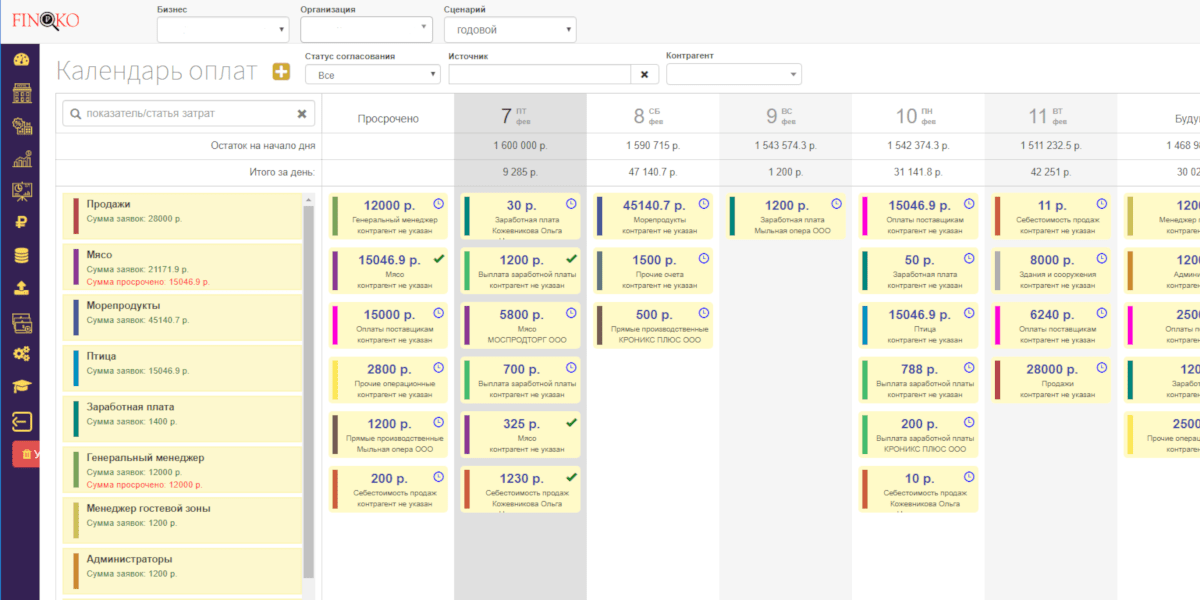Purpose of the payment calendar
The payment calendar in the hotel is an additional (external) module for 1C:Accounting, which allows you to combine information about the needs of the organization and its divisions in cash with the projected volumes of receipts from buyers (customers) and other sources into a single information space that ensures transparency and predictability of data, as well as significantly increases the efficiency of the company’s cash management.
Money Flow Planning
Agreeing on payment requests
Scheduled payments must be made on the basis of applications approved by authorized persons. The application submitted for approval shall specify:
- the initiator of the payment is the full name of the specialist who is responsible for the payment,
- Financial Responsibility Center / Division – where the payment belongs,
- purpose of payment,
- payment amount,
- the document – basis – the contract number and a link to the contract clause or invoice,
- payment due date,
- the cost item code in accordance with the coding adopted in the budgeting system,
- the reporting period of the Budget.
Determining payment priorities.
There are periods when the amounts of requests for payments submitted for execution to the finance department / accounting department exceed the amount of funds that the Company currently has. To do this, all cost items in the Budget classifier must be pre-determined by priorities. For example, you can define a number of cost items by the degree of importance:
– the priority payments should include: Tax payments, payment of wages, lease payments in accordance with the terms of lease agreements, current and overdue accounts payable under concluded contracts.
– secondary payments are payments on restructured debt, dividends to shareholders, and other current payments with low priorities.
Liquidity management \ cash gaps.
Liquidity management within the budget is aimed at preventing the occurrence of cash shortages (cash gaps). The company can avoid the occurrence of cash gaps by: attracting borrowed funds from outside (loans, loans, overdrafts on settlement accounts); reserves created in advance; restructuring accounts payable / receivables; or reducing payments, reducing budget limits. The choice of the method of covering cash gaps depends on the priority of payments and the size of the deficit and decisions are made individually. If the Company’s payment calendar is formed as accurately as possible, then it is possible to determine the periods of cash gaps in advance, and take effective measures to eliminate it.
The method of launching the Payment calendar at the enterprise
- First of all, it is necessary to develop cash flow items. For more information, see the article “Cash Flow Budget” and use the articles as money flow analytics in the 1C program:Accounting
- Start registering essential information about the terms of contracts in the program, such as: the number of days of deferral that your company gives to Customers, the schedule of your payments to Suppliers. To enter such information, you need to configure the Contract directory in the 1C program:Accounting.
- Purchase a Calendar planning module for 1C from Sun City:Accounting Department and start analyzing planned and actual data.
Payment Calendar – time money
Software product “The payment calendar in 1C: Accounting 8” is designed for operational management of the receipt and expenditure of funds. The main purpose of the software product is to provide the necessary amount of money to pay for scheduled payments.
The program is designed as an addition to the standard configuration “1C: Accounting 8 Prof. edition 3” and is a configuration that includes the following functionality:
- planning the receipt of funds from buyers,
- planning payments to suppliers and other creditors,
- maintaining the payment calendar of the organization in the context of types of funds, counterparties and contracts, as well as the classifier of articles of use of funds.
The planning system is based on the use of actual accounting data, as well as data on expected receipts and planned payments.
Cash flow planning
A flexible planning system allows you to calculate the planned receipt and expenditure of funds on the basis of data on the amount of payments provided to customers and the payment schedule for concluded contracts with suppliers.
The module “Payment calendar” allows you to plan the receipt of funds from buyers and customers. The parameters of upcoming receipts (date of receipt, counterparty, amount, etc.) are entered into the program using additional details of the contract with the Counterparty and information in the documents of sale of goods and services. This data entry mode allows you to significantly reduce the amount of data entered by users.
Information about the actual receipt of cash and non-cash funds from counterparties is reflected in the Payment calendar and reports of the program automatically and allows you to quickly monitor and predict the dynamics of cash receipts.
Payment planning
The module “Payment Calendar” provides an effective way for the operational planning of payments to the company.
The program provides a convenient payment planning assistant that allows financial responsibility centers to form requests for payments to suppliers and other counterparties.
The generated applications can go through the approval procedure. The module “Payment calendar” provides for the possibility of docking with the 1C configuration:The document flow in which the procedure for approving applications for expenses takes place.
A convenient and informative application management log is provided for the analysis and approval of applications. If the “Payment Calendar” module is used in conjunction with the Revenue and Expenditure Budget module, the system allows you to control the excess of the spending limit at the stage of registration of the Application in the Central Federal District.
Making payments (forming payment orders)
The “Payment Calendar” module allows for additional ranking of approved payment requests, including them in the register of payments of the current day. This approach helps to align the spending plan with the actual balances on current accounts.
The register of payments may undergo additional approval (approval) from the top management of the company.
Based on the agreed and approved register of payments, the system allows you to automatically generate payment orders.
In order for the Cash Flow Budget to work, it is necessary to specify the Money Flow Item and the CFR for each payment. If the payment orders were created by the Payment Calendar system, then no additional actions are required when the bank is posted. The module automatically detects the article of the movement of money and the Central Federal District when downloading data from the client’s bank, which greatly simplifies the cashier’s work.

